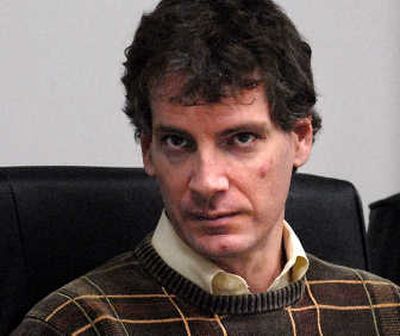Duncan admits to all 10 counts

BOISE – A chilling tale of child molestation and murder emerged in a Boise courtroom Monday, as Joseph Duncan pleaded guilty to all counts in a federal indictment for kidnapping and molesting two North Idaho children in 2005 and killing one.
The remaining question is whether Duncan will be put to death for his crimes or spend the rest of his life in prison. A federal jury will be convened late next month to decide that.
Duncan, his wispy hair now grown near shoulder-length, sat between two of his lawyers, clad in a bright orange jumpsuit. He told the judge he accepts responsibility for his crimes.
“I will continue to accept that responsibility to the death, if necessary,” he said.
The 44-year-old convicted murderer had been scheduled to go to trial next month in federal court for kidnapping young Dylan and Shasta Groene from their home east of Coeur d’Alene and killing Dylan, who was 9. The kidnappings came after he killed the children’s mother, Brenda Groene; her fiancé, Mark McKenzie; and the children’s older brother, Slade Groene, in a bloody attack. He pleaded guilty to those three murders in state court in Kootenai County last year. If Duncan doesn’t get a death sentence in the federal case, he still could get one on the state charges.
Now, Duncan has pleaded guilty to all 10 federal charges, three of which carry the death penalty.
It’s not clear whether the guilty pleas will spare Shasta Groene, now 10, from testifying. The federal penalty proceedings will focus on the aggravating factors that could make Duncan’s crimes against Dylan heinous enough to warrant a death sentence; Shasta is the only witness to those events.
Duncan insisted in court Monday that he’d never claimed innocence. Before pleading guilty, he read a statement.
“I just want to say that since my arrest, that I have never attempted to deny responsibility or to conceal anything that I have done concerning these charges,” Duncan told the court. “And so my plea today is not a confession in the sense that I have not already confessed a long time ago. It is instead merely an affirmation of the responsibility that I accepted when I brought the child S.G. home and allowed myself to be arrested.”
Attorneys on both sides are barred by court order from discussing the case.
Katie Ross, an attorney with the Death Penalty Assistance Center in Seattle who is not associated with the Duncan case, said that in general the decision to plead guilty is up to the client. Admitting guilt without a plea agreement could limit evidence that is presented to a jury that decides whether the pleader receives the death penalty. But that’s not automatic, she said.
“It could be (a step taken) if a client is truly remorseful, wants to take responsibility or not have a victim testify,” Ross said.
Shasta, then 8, was the only survivor of the attack; she was rescued when she was spotted with Duncan at a Denny’s restaurant in Coeur d’Alene in July 2005.
Federal prosecutor Traci Whelan read the charges against Duncan, along with a recitation of the facts of the case that both sides had agreed upon. They detailed Duncan’s actions starting in April 2005, when he purchased video recording equipment and stole a Jeep Cherokee and a 12-gauge shotgun, all of which he used in the crimes.
Duncan went to the Groene home to kidnap the two children, Whelan said. He bound the other victims with zip ties and duct tape and killed them, then took the children in the stolen Jeep to a remote area in the Lolo National Forest “and threatened to kill them if they did not obey him.”
Duncan repeatedly molested both children; Whelan’s recitation included graphic descriptions of the nature of the abuse. It also included a description of how Duncan videotaped his abuse of Dylan in an old wooden cabin in June 2005 and then shot the boy to death with the stolen gun.
Whelan said that after Shasta was rescued, “subsequent lab testing identified the defendant as her abuser.”
U.S. District Judge Edward Lodge asked Duncan, “You admit that those facts are true?”
“Yes, I do,” Duncan responded.
The judge read each of the 10 charges to Duncan, asking him for his plea. Ten times, his voice low and sometimes cracking, Duncan answered, “Guilty.”
Kootenai County Prosecutor Bill Douglas said the “incredible ability” of Shasta Groene and her father, Steve Groene, and the McKenzie and Groene families to endure the tragedy “has been a real inspiration to us all.”
“I don’t think there can ever be complete closure from an incident like this,” Douglas said. “At least this puts them one step further to putting this behind them.”
Duncan, a Tacoma native, has spent much of his adult life in Washington state prisons for sex crimes against children. He was on the run from a child molestation charge in Minnesota when he drove past the Groene home on Interstate 90 east of Coeur d’Alene in May 2005 and spotted Shasta and Dylan playing outside.
Duncan also could face a death penalty in California for the 1997 slaying of 10-year-old Anthony Martinez, and he is a suspect in the murders of two girls in the Seattle area in 1996, 9-year-old Carmen Cubias and 11-year-old Sammiejo White.